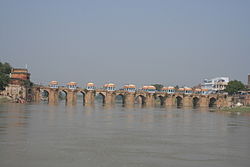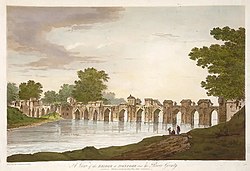Shahi Bridge | |
|---|---|
 Panoramic view of Shahi bridge | |
| Coordinates | 25°44′55″N 82°41′05″E / 25.74870°N 82.68468°E |
| Crossed | Gomti River |
| Locale | Jaunpur |
| Official name | Akbari Bridge |
| Maintained by | Directorate of Archaeology, (U.P.) UP-PWD UP Bridge corporation |
| Heritage status | 1978 |
| Preceded by | Boat Bridge of Sharki's |
| Followed by | Sadbhavana Bridge |
| Characteristics | |
| Design | Arch bridge |
| History | |
| Designer | Afzal Ali |
| Construction start | 1564 |
| Construction end | 1567 |
| Opened | 1567 |
| Collapsed | 1934 (partial i.e. ⅓) |
| Statistics | |
| Toll | free |
| Location | |
 | |
Shahi Bridge or Munim Khan's Bridge or Akbari Bridge or Mughal Bridge or Jaunpur Bridge is a 16th-century bridge over river Gomti in Jaunpur, Uttar Pradesh, India. The Shahi Bridge is located 1.7 kilometres (1.1 mi) north of Jaunpur Railway station, 7.3 kilometres (4.5 mi) northwest of Zafarābād, 16.2 kilometres (10.1 mi) north-northeast of Mariāhū and 26.6 kilometres (16.5 mi) west-northwest of the town of Kirākat.[1]

